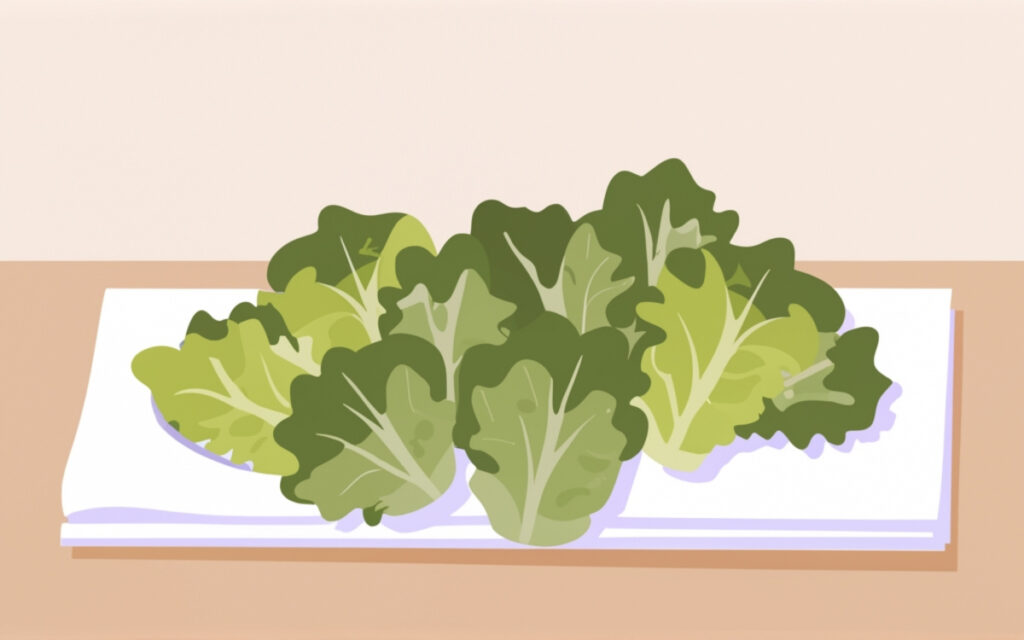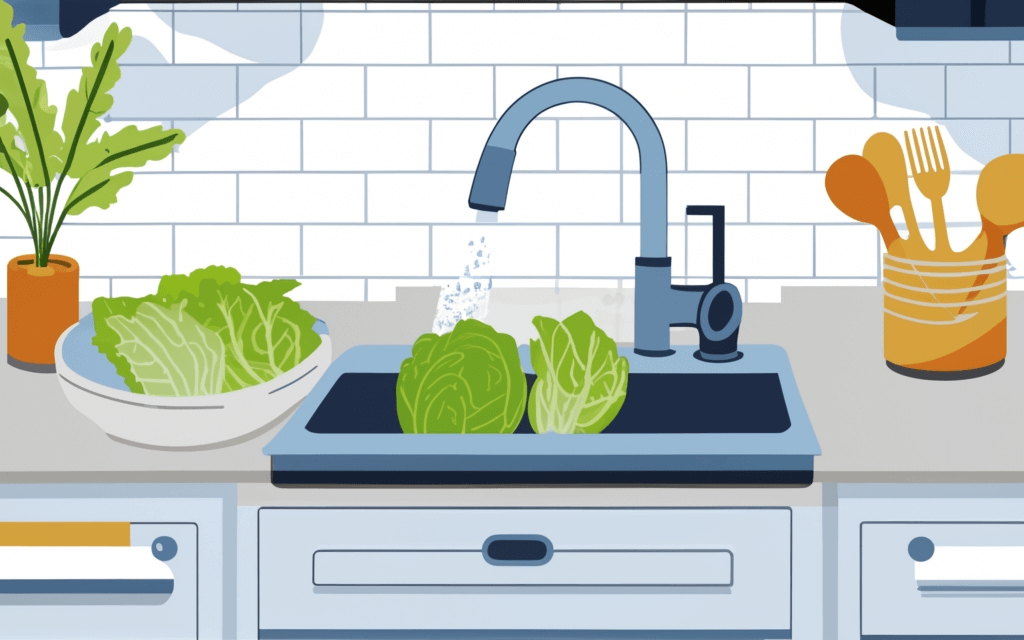Washing and drying lettuce properly is a crucial step in preparing fresh salads and other dishes to ensure the greens are clean and free of grit.
You don’t need the best salad spinner to get crisp, clean lettuce leaves if you have a few simple household items.
It’s important to clean lettuce thoroughly because the leaves can harbor soil and bacteria that compromise your dish’s flavor and texture and pose health risks.1
The process begins by separating the leaves to remove any trapped dirt and rinsing them under cold running water. Without the convenience of a spinner, you can employ alternative methods to dry the leaves effectively, ensuring that your lettuce is moisture-free and salad-ready.
Techniques like a clean kitchen towel, paper towels, or even just leaving the lettuce to air dry on a rack can be effective. Drying lettuce thoroughly is essential because it helps dressings adhere to the leaves, giving your salad the perfect flavor, consistency, and crunch.
Preparing the Lettuce
Before you wash and dry lettuce without a spinner, selecting fresh lettuce and thoroughly inspecting it for dirt and potential contaminants is crucial. Proper initial preparation ensures that your lettuce is not only clean but also ready to be dried effectively.
Choosing and Inspecting Lettuce
When selecting lettuce, look for vibrant, crisp leaves free from dark or slimy spots. Freshness is key, so avoid any heads of lettuce that appear wilted or have a dull color. Once you’ve chosen your lettuce, begin by inspecting it closely.
You’re checking for hidden dirt, debris, or signs of pests. It’s especially important to take note of the undersides of leaves, where contaminants commonly reside.
Separating the Leaves
After inspection, gently separate the leaves from the core. Discard any damaged or bruised outer leaves, as these can harbor more dirt and pesticides. By detaching each leaf, you’re ensuring that you can remove hidden dirt from every crevice. This step is essential because debris, pesticides, and harmful metals 2 often lurk in the folds and base of the leaves, areas that are difficult to clean if the head remains intact.
Washing the Lettuce
Before diving into the process, recognize that effectively washing lettuce is crucial to ensuring it’s free from dirt and potential contaminants. Cold water is your primary tool for rinsing, while a vinegar solution can be an additional safeguard.
Rinsing with Cold Water
Begin by separating your lettuce leaves to allow a thorough rinse. You’ll want to ensure that cold water reaches all the nooks and crannies of the leaves. Place the leaves in a large bowl of cold water and swish them gently to dislodge any dirt. After swirling, carefully lift the leaves out, leaving any sediment behind. This simple action helps reduce the risk of consuming unwanted residues.
Using Vinegar Solution
For an extra level of cleansing, especially to reduce microbes, prepare a vinegar solution. Mix one part vinegar with three parts water in a bowl. Immerse the salad greens in this mixture for a few minutes. Rinse the leaves again with cold water to remove the vinegar taste. This step isn’t necessary for every wash, but it’s a useful tactic when you want to be extra cautious.
Drying the Lettuce
After washing your lettuce, the next essential step is removing excess water to ensure your salad greens are crisp and dry. Employing the right drying technique is crucial to the texture and overall quality of your lettuce.
Towel Drying Method
Begin by laying out a clean kitchen towel or paper towels on a flat surface. Spread the washed lettuce leaves in a single layer across the towel. Gently roll the towel with the lettuce inside and press lightly to absorb the moisture. This method helps dry lettuce effectively by using a towel to wick away water.
Pillowcase Swinging Method
For a more dynamic approach, use a clean pillowcase. Place salad greens inside the pillowcase, gather the open end and hold it securely closed. Step outside or find an uncluttered space, and swing the pillowcase around. Centrifugal force will help dry the lettuce, giving you a drier result similar to that of a spinner.
Air-Drying Technique
Sometimes, simple air drying can be effective. After patting the lettuce down with kitchen towels, you can spread the leaves out on a cooling rack or clean cloth. Leave ample space between leaves for air circulation. This method requires patience, but it allows the leaves to dry in a natural, albeit slower, manner without bruising the tender greens.
Storing the Lettuce
Proper storage of your washed and dried lettuce is critical to maintaining its freshness. You have several options, whether you have access to refrigeration or not.
Refrigeration
First, store lettuce in the refrigerator to ensure it is completely dry to avoid any excess moisture, which can lead to spoilage. Use a clean, dry paper towel to gently wrap the lettuce, helping to absorb any residual moisture. Place the wrapped lettuce in a perforated plastic bag to allow for air circulation, and set it in the crisper drawer of your refrigerator. This method can help maintain freshness for several days.
Using Plastic Bags
If you’re using plastic bags for storage, opt for those with tiny holes to prevent excess moisture buildup. After drying your lettuce, gently place it in the bag. It’s important not to pack the leaves too tightly to minimize bruising. Before sealing the bag, let out as much air as you can by lightly pressing down on it. Place the bagged lettuce in the refrigerator‘s crisper section.
Storing Without Refrigeration
When refrigeration isn’t an option, you’ll need to consume your lettuce quickly to ensure freshness. Keep it in a cool, dry place out of direct sunlight. You can loosely wrap the lettuce in a plastic bag with a damp paper towel to keep the leaves moist and crisp for a short period of time. Remember, without refrigeration, lettuce will hold its freshness for only a day or two, so plan to use it accordingly.
Safety Considerations

When preparing lettuce, it’s crucial to consider steps that mitigate the risk of foodborne illnesses. Proper cleaning procedures are essential to reduce the presence of harmful bacteria such as E. coli and Salmonella.
Understanding Foodborne Illnesses
Foodborne illnesses often stem from harmful bacteria that can be present in fresh produce, including lettuce. To reduce your risk of food poisoning, it is critical to wash lettuce thoroughly. This involves rinsing the leaves under cold water to remove potential contaminants. Additionally, it’s beneficial to be aware that E. coli 3 and Salmonella are common pathogens linked to lettuce. Vigilant handling and proper sanitation can significantly decrease the chances of these bacteria causing illness.
Handling Pre-washed Lettuce
Even if your lettuce is labeled as pre-washed, it’s wise to treat it with caution. Food safety experts recommend giving pre-washed lettuce an additional rinse to ensure any harmful bacteria that might have been missed during commercial washing are removed. Keep in mind that while pre-washed lettuce is convenient, it’s not a guarantee against foodborne illness.
Incorporating Lettuce into Meals

Once you have your lettuce clean and dry, it’s time to make it a staple in your daily meals. Lettuce offers crisp freshness to various dishes, making it ideal for simple and complex salad recipes.
Salad Preparation
To prepare a salad, start by chopping the lettuce into bite-sized pieces to ensure ease of eating. Opt for a variety of types, such as romaine or butter lettuce, for textural contrast and visual appeal. Consider the season when choosing your salad ingredients; add vibrant, in-season vegetables or fruits for a vegan summer salad. Always toss your salad with a dressing just before serving to keep the lettuce crisp. Remember, meal prep for salads can be a time-saver; just store your dry lettuce and additional salad components separately in the fridge.
Ingredients:
- Chopped lettuce
- Seasonal vegetables/fruits
- Your favorite dressing
Steps:
- Chop lettuce and components.
- Mix in a large bowl.
- Add dressing before serving.
Using Lettuce in Recipes
Lettuce can be much more than the base of a salad. Incorporate it into your recipes to add a refreshing crunch. Use whole leaves as a healthy wrap for tacos or spring rolls, perfect for a light summer meal.
You can also chop it into thin strips to top off soups, stews, and sandwiches. When meal prepping, consider recipes where lettuce can be added last to maintain its texture and nutrient content.
Tips for Perfect Lettuce
Achieving perfect lettuce entails meticulous washing and drying to enhance crispness while avoiding damage. Let’s explore how you can prepare various types of lettuce, including romaine, arugula, kale, and butter lettuce, ensuring they remain vibrant and ready for your salads.
Avoiding Bruising
To prevent bruising, handle your lettuce gently. When washing, avoid forcefully rubbing the leaves. For tender types like butter lettuce and spinach, use a light touch:
Do:
- Submerge leaves in cold water.
- Swirl gently to loosen any debris.
Don’t:
- Squeeze or wring out leaves.
- Overcrowd your washing container.
Remember, delicate leaves bruise easily, so the less pressure you apply, the better.
Enhancing Crispness
Drying thoroughly is crucial for that sought-after crisp texture in lettuce, especially in romaine and kale. Here’s how to ensure your greens stay crisp without a salad spinner:
- Lay washed leaves on a clean, absorbent towel.
- Roll up the towel gently with the lettuce inside to soak up excess water.
- Alternatively, lay out the leaves on the towel and pat dry.
For an Ina Garten-approved method, place the leaves in a dish towel, gather the corners, and give it a gentle twirl. This action mimics the effect of a salad spinner, without the equipment.
Patience is key; rushing the drying process can lead to wilted or still-wet leaves which diminish the quality of your greens. By following these steps, you’ll enjoy crisp, bruise-free lettuce, perfect for any dish.
Frequently Asked Questions
In this section, you will find answers to common concerns when it comes to washing and drying lettuce without the use of a salad spinner.
What is the best method to dry lettuce without using a salad spinner?
The most effective way to dry lettuce without a spinner is to lay the leaves on a clean towel, roll it up gently with the lettuce inside, and press lightly to absorb excess water. Another method involves laying the leaves on paper towels to air dry naturally.
Can lettuce be dried effectively in the oven without wilting?
Drying lettuce in the oven is not recommended as it could lead to wilting or even baking the leaves. Lettuce is too delicate for the heat of an oven and should instead be dried using cooler, air-based methods.
How can you ensure lettuce is bacteria-free when washing it without a spinner?
To remove bacteria, wash your lettuce under cold running water while rubbing the leaves gently with your fingers. After washing, you can sanitize the lettuce by soaking it in a solution of water and vinegar (1 part vinegar to 3 parts water) for a few minutes before the final rinse.
What are some practical hacks for drying salad that don’t involve a spinner?
You can place lettuce leaves in a clean kitchen towel or tea towel, gather the corners to form a pouch and swing it gently to centrifuge the water out. Additionally, Ina Garten’s trick involves twirling the bundle to use centrifugal force, which mimics a spinner’s effect.
How can you keep washed lettuce crisp and fresh when drying by hand?
After hand washing, dry the lettuce gently by patting it with towels to minimize moisture without crushing the leaves. Keep the lettuce refrigerated in a sealed container with paper towels to absorb moisture and maintain crispness.
Are there any household items that can substitute for a salad spinner, and how are they used?
A colander and a kitchen towel can substitute for a salad spinner. Shake the washed lettuce in a colander to remove excess water, then lay out the leaves on a towel to dry. If you have a large container with a lid, you can mimic a spinner by gently shaking the container to fling the water off the leaves.



